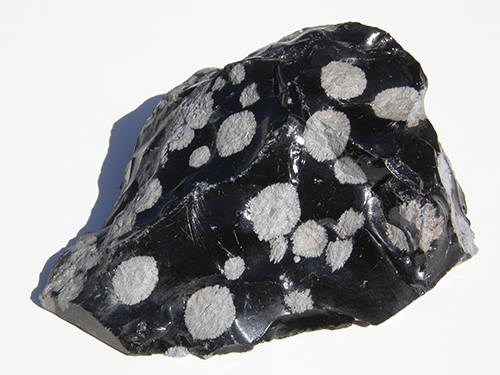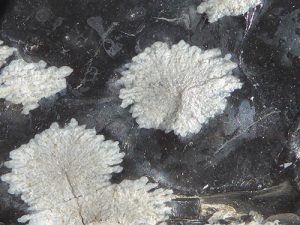
By Jim Brace-Thompson
Silica dioxide (SiO2)
Quartz, or silica dioxide (SiO2), is a common mineral beloved by crystal collectors of all stripes. No collection is complete without its sparkly hexagonal points. However, not all silica dioxide crystallizes in this form. When it crystallizes within volcanic rocks at high temperatures above 1,470°C, it forms a mineral called cristobalite. Chemically, it is identical to common quartz, but its crystal structure is distinctly different, making it a polymorph with quartz.
“Polymorph” means “many or multiple forms” and, in mineralogy, the term applies to minerals that have the same chemical composition but differing crystal structure.
Cristobalite’s Intricate Appearance

Rather than the pointed hexagonal crystals of quartz, cristobalite grows as cubic-form crystals (pseudo-octohedrons) that tend to be microscopically small. These sometimes appear as twinned inter growths called spinel twins. A more commonly observed habit is radiating clusters. These appear as “spherulites” (rounded, ball-like masses) in small shrinkage cavities known as lithophysae within volcanic rocks. Perhaps their best known representation to everyday rockhounds is as the “snowflakes” in snowflake obsidian.
Cristobalite has a frosty or milky white appearance that clears if heated to 175°C then reverts back upon cooling. I have also read that it is often fluorescent, but I didn’t see much of an affect under my own UV lamp; the half-dozen specimens I have of snowflake obsidian won’t be going into my fluorescent mineral display case any time soon.
Its name comes from the locality of Cerro San Cristóbal near Pachuca, Hidalgo, Mexico. Snowflake obsidian is also found in many other places, such as Italy and the U.S. states of Colorado, Utah, and northern California, but cristobalite has been found in localities worldwide. It has even been reported to exist on the moon! Rock samples brought back to earth in the 1970s by the Apollo 14, 15, 16, and 17 missions all included cristobalite.
Author: Jim Brace-Thompson
 Founder and overseer of the AFMS Badge Program for kids.
Founder and overseer of the AFMS Badge Program for kids.
He’s also an inductee of the National Rockhound & Lapidary Hall of Fame within the Education Category.














